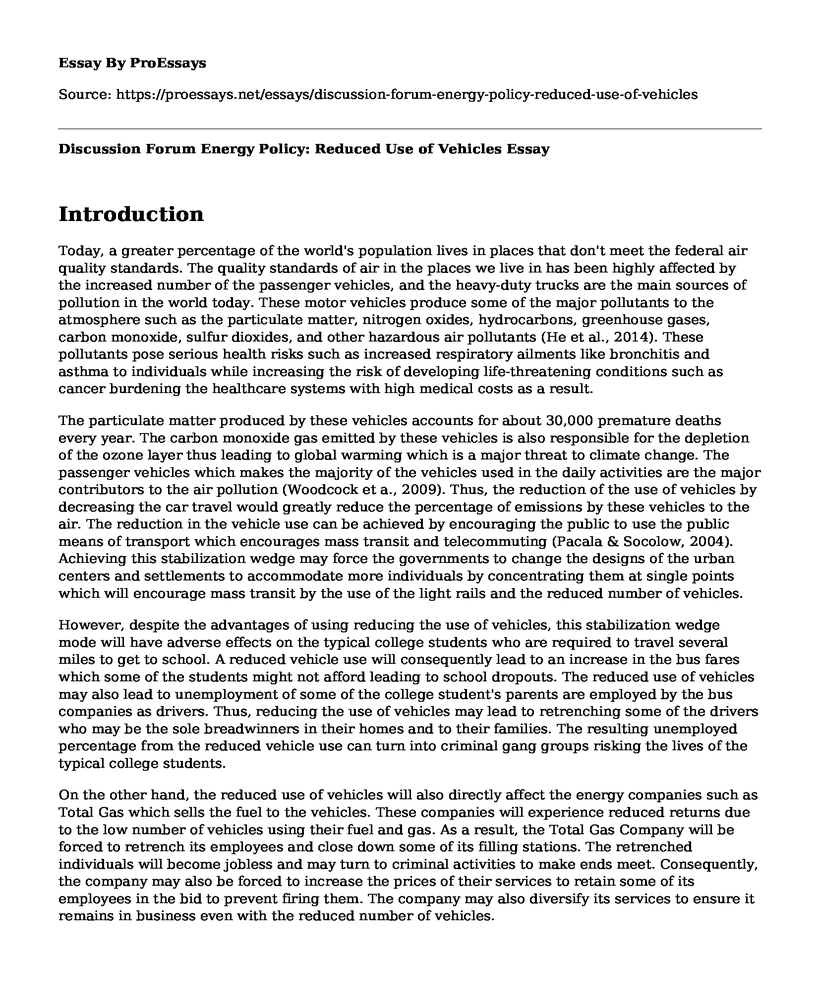Introduction
Today, a greater percentage of the world's population lives in places that don't meet the federal air quality standards. The quality standards of air in the places we live in has been highly affected by the increased number of the passenger vehicles, and the heavy-duty trucks are the main sources of pollution in the world today. These motor vehicles produce some of the major pollutants to the atmosphere such as the particulate matter, nitrogen oxides, hydrocarbons, greenhouse gases, carbon monoxide, sulfur dioxides, and other hazardous air pollutants (He et al., 2014). These pollutants pose serious health risks such as increased respiratory ailments like bronchitis and asthma to individuals while increasing the risk of developing life-threatening conditions such as cancer burdening the healthcare systems with high medical costs as a result.
The particulate matter produced by these vehicles accounts for about 30,000 premature deaths every year. The carbon monoxide gas emitted by these vehicles is also responsible for the depletion of the ozone layer thus leading to global warming which is a major threat to climate change. The passenger vehicles which makes the majority of the vehicles used in the daily activities are the major contributors to the air pollution (Woodcock et a., 2009). Thus, the reduction of the use of vehicles by decreasing the car travel would greatly reduce the percentage of emissions by these vehicles to the air. The reduction in the vehicle use can be achieved by encouraging the public to use the public means of transport which encourages mass transit and telecommuting (Pacala & Socolow, 2004). Achieving this stabilization wedge may force the governments to change the designs of the urban centers and settlements to accommodate more individuals by concentrating them at single points which will encourage mass transit by the use of the light rails and the reduced number of vehicles.
However, despite the advantages of using reducing the use of vehicles, this stabilization wedge mode will have adverse effects on the typical college students who are required to travel several miles to get to school. A reduced vehicle use will consequently lead to an increase in the bus fares which some of the students might not afford leading to school dropouts. The reduced use of vehicles may also lead to unemployment of some of the college student's parents are employed by the bus companies as drivers. Thus, reducing the use of vehicles may lead to retrenching some of the drivers who may be the sole breadwinners in their homes and to their families. The resulting unemployed percentage from the reduced vehicle use can turn into criminal gang groups risking the lives of the typical college students.
On the other hand, the reduced use of vehicles will also directly affect the energy companies such as Total Gas which sells the fuel to the vehicles. These companies will experience reduced returns due to the low number of vehicles using their fuel and gas. As a result, the Total Gas Company will be forced to retrench its employees and close down some of its filling stations. The retrenched individuals will become jobless and may turn to criminal activities to make ends meet. Consequently, the company may also be forced to increase the prices of their services to retain some of its employees in the bid to prevent firing them. The company may also diversify its services to ensure it remains in business even with the reduced number of vehicles.
References
He, H., Wang, Y., Ma, Q., Ma, J., Chu, B., Ji, D., ... & Hao, J. (2014). Mineral dust and NOx promote the conversion of SO 2 to sulfate in heavy pollution days. Scientific reports, 4, 4172.
Pacala, S., & Socolow, R. (2004). Stabilization wedges: solving the climate problem for the next 50 years with current technologies. Science, 305(5686), 968-972.
Woodcock, J., Edwards, P., Tonne, C., Armstrong, B. G., Ashiru, O., Banister, D., ... & Franco, O. H. (2009). Public health benefits of strategies to reduce greenhouse-gas emissions: urban land transport. The Lancet, 374(9705), 1930-1943.
Cite this page
Discussion Forum Energy Policy: Reduced Use of Vehicles. (2022, Jun 19). Retrieved from https://proessays.net/essays/discussion-forum-energy-policy-reduced-use-of-vehicles
If you are the original author of this essay and no longer wish to have it published on the ProEssays website, please click below to request its removal:
- Ecology Essay Example on Clean Air Act
- Climate Change: An Annotated Bibliography Example
- Forest Restoration in Landscapes Essay Example
- Essay Sample on Business Issues
- Essay on Achieving Sustainable Economic and Environmental Balance: A Challenge Ahead
- Paper Sample on Climate Change and Rainfall in Sub-Saharan Countries: Challenges and Solutions
- The Fisheries Policy - Essay Example







